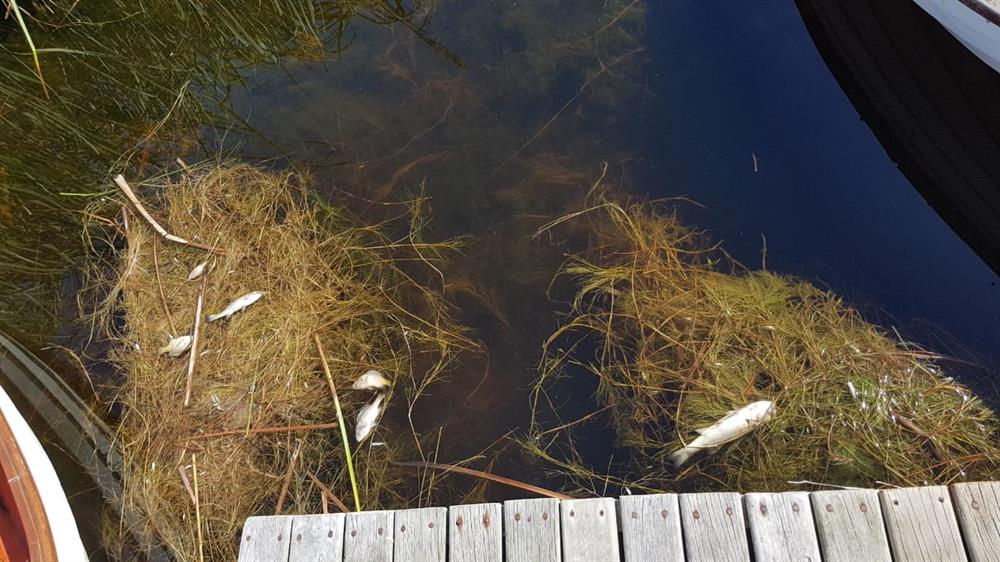KNYSNA NEWS - The dead fish at Groenvlei, which Knysna-Plett Herald reported on recently, could constitute a much bigger problem than many people thought.
Residents of Groenvlei near Sedgefield, fishing enthusiasts and conservationists alike are concerned that the ever-growing carp population in the vlei's waters could have a permanent detrimental effect on the ecology of the area if attention isn't given to the issue as soon as possible.
The first to draw attention to the issue halfway through 2018 was a group of Sedgefield locals whose concerns, they say, were justified when a number of fish went belly-up in October last year, possibly the cause of a carp-spawning episode which was confirmed by conservation authority CapeNature at the time. The group of Groenvlei residents and conservationists are now worried that a second carp spawning in coming weeks will have an even greater negative effect.
Nets destroyed in 2017 fires
In the past, it is said, gill nets and bow fishing were used to control the carp population, but the nets were destroyed in the 2017 Knysna fires, and the bow fishing programme was ended in 2018. According to CapeNature spokesperson Loren Pavitt, the nets used to eradicate carp from the lake between 2000 and 2016 were all burnt during the 2017 fires, even after they were stolen and replaced in 2010.
Both CapeNature and the SA Institute for Aquatic Biodiversity (SAIAB) are working on the problem.
In March to December 2018, Pavitt said, an experimental bow-hunting project was implemented using a local specialised team of bowmen from the Sedgefield community to determine the effects of eradicating the carp by means of a bow and arrow. "This method has proven very effective, where approximately 5.5 tons of adult carp have been eradicated from Groenvlei lake to date," she said, adding that CapeNature is in the process of evaluating all aspects of this experimental project with the bow hunting team and with scientists alike, "to determine the best way forward to manage the carp population in the future".
'Report illegal activities'
Answering a question from concerned locals as to how they could assist, Pavitt said the public could help by firstly reporting any illegal activities taking place on the lake to the conservation manager of Goukamma Nature Reserve & Marine Protected Area.
In addition, Pavitt encouraged freshwater anglers "not to practise 'catch-and-release' for carp", and should take their catch home as this will assist with the eradication programme.
"Local residents of Sedgefield/Buffalo Bay are encouraged to attend the reserve's Protected Area Advisory Committee (PAAC) meetings where various ecological topics and concerns can be raised and discussed," Pavitt added.
Another role player in the situation is SAIAB postdoctoral scientist Dr Josephine Pegg, who will be conducting research into carp in South Africa, including the Knysna/Sedgefield area specifically.
Pegg said the problem with these carp outside their native range is that they have few natural predators here, thus nothing to keep their numbers in check. She said this hardy fish species has been introduced to bodies of water globally, on all continents, with the exception of Antarctica.
'Problematic fish'
"Carp are considered one of the more problematic invasive species, as they eat anything and do really well in poor conditions… they thrive where other fish don't. Their way of feeding impacts on these bodies of water most as they feed along the bottom of ponds, rivers and lakes and overturn sediment," Pegg explained.
In the case of Groenvlei, she said, which is about 30 000-plus years old, the carp are churning up rotten material continuously, releasing this old sediment, filled with all kinds of nutrients, and upsetting the balance of the lake. They do this all over their invasive range, and being quite clever fish, they prove a challenge to catch. That is why people like catching them," she added.
 Photos show dead fish at Groenvlei, in October 2018. Residents and authorities agreed that the carp population was at least partly responsible. Photo: Supplied
Photos show dead fish at Groenvlei, in October 2018. Residents and authorities agreed that the carp population was at least partly responsible. Photo: Supplied
Pegg commended CapeNature for their hard work in trying to control the situation thus far, and said SAIABs role in studying the carp at Groenvlei would be twofold. "We will firstly be looking at the ecology of the lake and its food webs, and how the carp fits into this. We need to monitor the population – how many are there, how and where they reproduce. In places like the UK, USA, Australia and New Zealand a lot of research has been done, which is needed in South Africa."
Secondly, said Pegg, SAIAB's role would be to supply CapeNature with a better insight on the carp population and its habits. "If one can intercept them before they spawn it will be a very useful way of controlling them," she said.
"In general we will be focusing on the basic ecology of Groenvlei to help CapeNature in finding solutions to the problem. Including the community in the project will also be of great importance," Pegg concluded.
SAIAB Chief Scientist and leader in research on invasive fish species, Prof Olaf Weyl, said that the institute was part of a larger research group working on the issue.
"This is a large collaborative project involving multiple partners. This includes SAIAB, CapeNature, Nelson Mandela University, SANParks as well as concerned members of the public," he added.
Read a previous article: Belly-up fish leave more questions than answers
'We bring you the latest Knysna, Garden Route news'
















